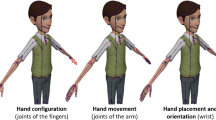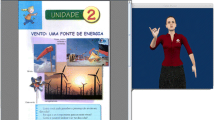Abstract
Signing avatars are increasingly used as an interface for communication to the deaf community. In recent years, an emerging approach uses captured data to edit and generate sign language (SL) gestures. Thanks to motion editing operations (e.g., concatenation, mixing), this method offers the possibility to compose new utterances, thus facilitating the enrichment of the original corpus, enhancing the natural look of the animation, and promoting the avatar’s acceptability. However, designing such an editing system raises many questions. In particular, manipulating existing movements does not guarantee the semantic consistency of the reconstructed actions. A solution is to insert the human operator in a loop for constructing new utterances and to incorporate within the utterance’s structure constraints that are derived from linguistic patterns. This article discusses the main requirements for the whole pipeline design of interactive virtual signers, including: (1) the creation of corpora, (2) the needed resources for motion recording, (3) the annotation process as the heart of the SL editing process, (4) the building, indexing, and querying of a motion database, (5) the virtual avatar animation by editing and composing motion segments, and (6) the conception of a dedicated user interface according to user’ knowledge and abilities. Each step is illustrated by the authors’ recent work and results from the project Sign3D, i.e., an editing system of French Sign Language (LSF) content (http://sign3d.websourd.org/sltat).








Similar content being viewed by others
References
Adamo-Villani, N., Hayward, K., Lestina, J., Wilbur, R.B.: Effective animation of sign language with prosodic elements for annotation of digital educational content. In: Siggraph talks. ACM (2010)
Arikan, O., Forsyth, D.A., O’Brien, J.F.: Motion synthesis from annotations. ACM Trans. Graph. 22(3), 402–408 (2003)
Awad, C., Courty, N., Duarte, K., Le Naour, T., Gibet, S.: A combined semantic and motion capture database for real-time sign language synthesis. In: Proceedings of the 9th International Conference on Intelligent Virtual Agents. Vol. 5773 of Lecture Notes in Artificial Intelligence, pp. 432–38. Springer, Berlin (2009)
Brun, R., Gibet, S., Hamon, L., Lefebvre-Albaret, F., Turki, A.: The SIGN3D project. http://sign3d.websourd.org/ (2012)
Cox, S., Lincoln, M., Tryggvason, J., Nakisa, M., Wells, M., Tutt, M., Abbott, S.: Tessa, a system to aid communication with deaf people. In: Proceedings of the Fifth International ACM Conference on Assistive Technologies. Assets ’02, New York, NY, pp. 205–212 (2002)
Crasborn, O., Sloetjes, H.: Enhanced elan functionality for sign language corpora. In: Proceedings of lrec 2008, Sixth International Conference on Language Resources and Evaluation (2008)
Cuxac, C.: Phonétique de la lsf: une formalisation problématique. In Silexicales - la linguistique de la lsf: Recherches actuelles, vol. 4 (2004)
Duarte, K.: Motion capture and avatars as portals for analyzing the linguistic structure of signed languages. Ph.D. Thesis, université de bretagne sud (2012)
Duarte, K., Gibet, S.: Heterogeneous data sources for signed language analysis and synthesis: the signcom project. In: Proceedings of the Seventh Conference on International Language Resources and Evaluation (lrec’10). European Language Resources Association (ELRA), Valletta (2010a)
Duarte, K., Gibet, S.: Reading between the signs: How are transitions built in signed languages? In: Theoretical Issues in Sign Language Research (TILSR 2010), Indiana, USA (2010b)
Efthimiou, E., Fotinea, S.E., Hanke, T., Glauert, J., Bowden, R., Braffort, A., Collet, C., Maragos, P., Lefebvre-Albaret, F.: Sign language technologies and resources of the dicta-sign project. In: Proceedings of the 5th Workshop on the Representation and Processing of Sign Languages: Interactions Between Corpus and Lexicon, Workshop to the Eighth International Conference on Language Resources and Evaluation (lrec-2012), pp. 37–45. European Language Resources Association (ELRA), Istanbul (2012)
Elliott, R., Glauert, J.R.W., Kennaway, J.R., Marshall, I.: The development of language processing support for the ViSiCAST project. In: Proceedings of the Fourth International ACM Conference on Assistive Technologies, Assets’00, pp. 101–108 (2000)
Elliott, R., Glauert, J.R.W., Jennings, V., Kennaway, J.: An overview of the sigml notation and sigML signing software system. In: Workshop on the Representation and Processing of Signed Languages, 4th International Conference on Language Resources and Evaluation (2004)
Elliott, R., Glauert, J.R.W., Kennaway, J.R., Marshall, I., Safar, E.: Linguistic modelling and language-processing technologies for avatar-based sign language presentation. Univ. Access Inf. Soc. 6, 375–391 (2008)
Filhol, M.: Combining two synchronization methods in a linguistic model to describe sign language. Hum. Comput. Inter. Embod. Commun. GW 2011 7206, 194–203 (2012)
Fotinea, S.E., Efthimiou, E., Caridakis, G., Karpouzis, K.: A knowledge-based sign synthesis architecture. Univ. Access Inf. Soc. 6(4), 405–418 (2008)
Gibet, S., Lebourque, T., Marteau, P.F.: High level specification and animation of communicative gestures. J. Vis. Lang. Comput. 12, 657–687 (2001)
Gibet, S., Marteau, P.F., Duarte, K.: Toward a motor theory of sign language perception. Hum. Comput. Inter. Embod. Commun. GW 2011 7206, 161–172 (2012)
Gibet, S., Héloir, A., Courty, N., Kamp, J.F., Gorce, P., Rezzoug, N., Multon, F., Pelachaud, C.: Virtual agent for deaf signing gestures. AMSE J. Assoc. Adv. Modell. Simul. Tech. Enterp. (Special edition HANDICAP) 67, 127–136 (2006)
Gibet, S., Courty, N., Duarte, K., Le Naour, T.: The SignCom system for data-driven animation of interactive virtual signers: methodology and evaluation. ACM Trans. Interact. Intell. Syst. 1(1), 6–23 (2011)
Glauert, J.R.W., Elliott, R.: Extending the sigml notation: a progress report (2011)
Hayward, K., Adamo-Villani, N., Lestina, J.: A computer animation system for creating deaf-accessible math and science curriculum materials. In: Proceedings of Eurographics 2010, Education Paper (2010)
Héloir, A., Gibet, S.: A qualitative and quantitative characterisation of style in sign language gestures. In: Gesture in Human–Computer Interaction and Simulation, GW, Lecture Notes in Artificial Intelligence, lNAI, p. 2009. Springer, Lisboa (2007)
Héloir, A., Courty, N., Gibet, S., Multon, F.: Temporal alignment of communicative gesture sequences. Comput. Anim. Virtual Worlds 17, 347–357 (2006)
Huenerfauth, M.: Generating American Sign Language classifier predicates for English-to-ASL machine translation. Dissertation, University of Pennsylvania (2006)
Huenerfauth, M., Lu, P.: Modeling and synthesizing spatially inflected verbs for American Sign Language animations. In: Assets, pp. 99–106 (2010)
Huenerfauth, M., Zhao, L., Gu, E., Allbeck, J.: Evaluation of American Sign Language generation by native ASL signers. ACM Trans. Access. Comput. 1(1), 1–27 (2008)
Johnson, R.E., Liddell, S.K.: A segmental framework for representing signs phonetically. Sign Lang. Stud. 11(3), 408–463 (2011a)
Johnson, R.E., Liddell, S.K.: Toward a phonetic representation of signs: sequentiality and contrast. Sign Lang. Stud. 11(2), 241–274 (2011b)
Johnston, T.: The lexical database of AUSLAN (Australian Sign Language). Lexical databases. In: Proceedings of the First Intersign Workshop, Hamburg (1998)
Kennaway, J.R.: Experience with, and requirements for, a gesture description language for synthetic animation. In: Proceedings of Gesture Workshop, LNCS, Genova, Italy (2003)
Kennaway, J.R., Glauert, J.R.W., Zwitserlood, I.: Providing signed content on the internet by synthesized animation. ACM Trans. Comput. Hum. Interact. 14(3), 15 (2007)
Kita, S., van Gijn, I., van der Hulst, H.: Movement phase in signs and co-speech gestures, and their transcriptions by human coders. In: Proceedings of the Gesture Workshop on Gesture and Sign Language in Human–Computer Interaction. Vol. 1371 of Lecture Notes in Computer Science, pp. 23–35. Springer, London (1997)
Lebourque, T., Gibet, S.: High level specification and control of communication gestures: the gessyca system. In: Proceedings of Computer Animation, Genova, Switzerland (1999)
Lefebvre-Albaret, F.: Segmentation de la langue des signes française par une approche basée sur la phonologie. Ph.D. Thesis, Université Paul Sabatier, Toulouse (2010)
Lenseigne, B., Dalle, P.: Using signing space as a representation for sign language processing. In: Gibet, S. (ed.) Gesture in Human-Computer Interaction and Simulation, GW, Lecture Notes in Computer Science, vol. 3881, pp. 256–260. Springer, Berlin (2006)
Lombardo, V., Nunnari, F., Damiano, R.: A virtual interpreter for the Italian Sign Language. In: Iva, pp. 201–207 (2010)
Losson, O.: Modélisation du geste communicatif et réalisation d’un signeur virtuel de phrases en langue des signes française. Ph.D. Thesis, Université de Lille(2000)
Lu, P., Huenerfauth, M.: Data-driven synthesis of spatially inflected verbs for American Sign Language animation. TACCESS 4(1), 4 (2011)
Marshall, I., Safar, E.: Grammar development for sign language avatar-based synthesis. In: Proceedings UAHCI (2005)
Prillwitz, S., Leven, R., Zienert, H., Hanke, T., Henning, J.: Hamburg Notation System for Sign Languages–An Introductory Guide. University of Hamburg Press, Hamburg (1989)
Ségouat, J.: Modélisation de la coarticulation en langue des signes française pour la diffusion automatique d’information en gare ferroviaire a l’aide d’un signeur virtuel. Ph.D. Thesis, Université Paris Sud (2010)
Websourd.: Evaluation of the sign wiki. In: Dicta-sign: Sign language Recognition, Generation and Modelling with Application in Deaf Communication, d8.2 (2012)
Wolfe, R., Cook, P., McDonald, J.C., Schnepp, J.: Linguistics as structure in computer animation: toward a more effective synthesis of brow motion in American Sign Language. Nonman. Sign Lang. Spec. Issue Sign Lang. Linguist. 14(1), 179–199 (2011a)
Wolfe, R., McDonald, J. C., Schnepp, J., Toro, J.: Synthetic and acquired corpora: meeting at the annotation. In: Workshop on Building Sign Language Corpora in North America, Washington, DC (2011b)
Acknowledgments
The Sign3D project was funded by the French Ministry of Industry (DGCIS: Direction Générale de la Compétitivité de l’Industrie et des Services, Program “Investissements d’avenir”).
Author information
Authors and Affiliations
Corresponding author
Rights and permissions
About this article
Cite this article
Gibet, S., Lefebvre-Albaret, F., Hamon, L. et al. Interactive editing in French Sign Language dedicated to virtual signers: requirements and challenges. Univ Access Inf Soc 15, 525–539 (2016). https://doi.org/10.1007/s10209-015-0411-6
Published:
Issue Date:
DOI: https://doi.org/10.1007/s10209-015-0411-6




